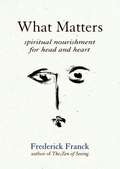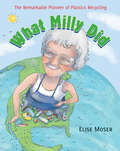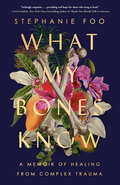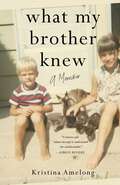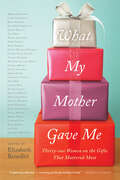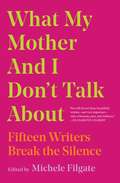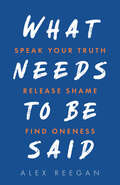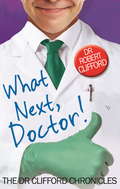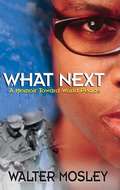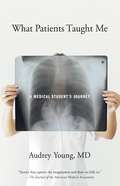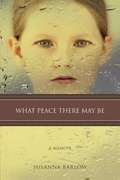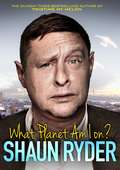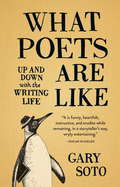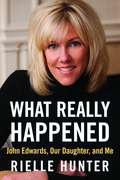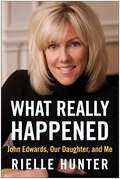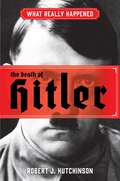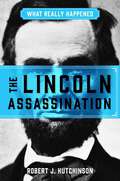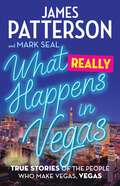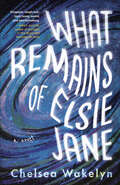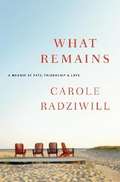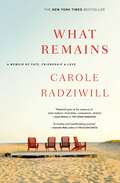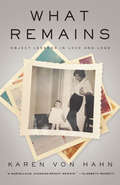- Table View
- List View
What Matters: Spiritual Nourishment for Head and Heart
by Frederick FranckAfter his nearly 100 years of seeding, Franck's reflections on what really matters will help you to savor what truly matters in your own life. "Could the meaning of being born human be, to become Human?" This elegantly simple book of reflections presents the rich harvest of a lifetime of thinking, feeling, and seeing by an artist, whose vital spirituality has inspired hundreds of thousands of readers and students through his art, books, and workshops. The pithy, sometimes humorous, always wise contemplations reveal Franck's lifelong confrontation with the human in himself and others. Originally jotted down as reflections for himself and close friends, Franck's insights will challenge you to consider new ways of experiencing your spiritual path and to savor what truly matters.
What Milly Did: The Remarkable Pioneer of Plastics Recycling
by Elise MoserThe extraordinary story of the woman who made plastics recycling possible. Milly Zantow wanted to solve the problem of her town’s full landfill and ended up creating a global recycling standard — the system of numbers you see inside the little triangle on plastics. This is the inspiring story of how she mobilized her community, creating sweeping change to help the environment. On a trip to Japan in 1978, Milly noticed that people were putting little bundles out on the street each morning. They were recycling — something that hadn’t taken hold in North America. When she returned to Sauk City, Wisconsin, she discovered that her town’s landfill was nearing capacity, and that plastic made up a large part of the garbage. No one was recycling plastics. Milly decided to figure out how. She discovered that there are more than seven kinds of plastic, and they can’t be combined for recycling, so she learned how to use various tests to identify them. Then she found a company willing to use recycled plastic, but the plastic would have to be ground up first. Milly and her friend bought a huge industrial grinder and established E-Z Recycling. They worked with local school children and their community, and they helped other communities start their own recycling programs. But Milly knew that the large-scale recycling of plastics would never work unless people could easily identify the seven types. She came up with the idea of placing an identifying number in the little recycling triangle, which has become the international standard. Milly's story is a glimpse into the early days of the recycling movement and shows how, thanks to her determination, hard work and community-building, huge changes took place, spreading rapidly across North America. Correlates to the Common Core State Standards in English Language Arts: CCSS.ELA-LITERACY.RI.3.3 Describe the relationship between a series of historical events, scientific ideas or concepts, or steps in technical procedures in a text, using language that pertains to time, sequence, and cause/effect. CCSS.ELA-LITERACY.RI.4.7 Interpret information presented visually, orally, or quantitatively (e.g., in charts, graphs, diagrams, time lines, animations, or interactive elements on Web pages) and explain how the information contributes to an understanding of the text in which it appears.
What Music!: The Fifty-year Friendship between Beethoven and Nannette Streicher, Who Built His Pianos
by Laurie LawlorStrings quivered. Notes shimmered. Meet best friends acclaimed composer Ludwig van Beethoven and bold female entrepreneur Nannette Streicher in this lively and lyrical nonfiction picture book.In a tall, narrow building on a wide avenue pianos plinked and plunked day and night.Everyone in quiet Augsburg knew the Stein home.What music!In 1787, aspiring yet unknown composer Ludwig van Beethoven arrives at young Nannette Stein&’s home. What follows is a decades-long friendship that persists whether life hits a low or high note. Acclaimed nonfiction writer Laurie Lawlor deftly depicts how these two fascinating friends—a composer with hearing loss and a woman who became an innovative piano maker in a time that discouraged female entrepreneurship—fought the odds and worked together in perfect harmony. The author of picture book biography Fearless World Traveler, Lawlor masterfully uses forgotten historical letters, a glossary, and rich back matter on both friends&’ lives and art to introduce readers to the man behind the music, from his loud laughter to his crushing handshake. Complete with Fearless World Traveler collaborator Becca Stadtlander&’s intricate mixed-media artwork, What Music deftly dives into musical history–and herstory–in an intimate yet expansive picture book biography that hits just the right note.
What My Bones Know: A Memoir of Healing from Complex Trauma
by Stephanie FooNEW YORK TIMES BESTSELLER • A searing memoir of reckoning and healing by acclaimed journalist Stephanie Foo, investigating the little-understood science behind complex PTSD and how it has shaped her life&“Achingly exquisite . . . providing real hope for those who long to heal.&”—Lori Gottlieb, New York Times bestselling author of Maybe You Should Talk to SomeoneONE OF THE BEST BOOKS OF THE YEAR: The Washington Post, Cosmopolitan, NPR, Mashable, She Reads, Publishers WeeklyBy age thirty, Stephanie Foo was successful on paper: She had her dream job as an award-winning radio producer at This American Life and a loving boyfriend. But behind her office door, she was having panic attacks and sobbing at her desk every morning. After years of questioning what was wrong with herself, she was diagnosed with complex PTSD—a condition that occurs when trauma happens continuously, over the course of years.Both of Foo&’s parents abandoned her when she was a teenager, after years of physical and verbal abuse and neglect. She thought she&’d moved on, but her new diagnosis illuminated the way her past continued to threaten her health, relationships, and career. She found limited resources to help her, so Foo set out to heal herself, and to map her experiences onto the scarce literature about C-PTSD.In this deeply personal and thoroughly researched account, Foo interviews scientists and psychologists and tries a variety of innovative therapies. She returns to her hometown of San Jose, California, to investigate the effects of immigrant trauma on the community, and she uncovers family secrets in the country of her birth, Malaysia, to learn how trauma can be inherited through generations. Ultimately, she discovers that you don&’t move on from trauma—but you can learn to move with it.Powerful, enlightening, and hopeful, What My Bones Know is a brave narrative that reckons with the hold of the past over the present, the mind over the body—and examines one woman&’s ability to reclaim agency from her trauma.
What My Brother Knew: A Memoir
by Kristina AmelongFor readers who were inspired by Alua Arthur&’s Briefly Perfectly Human, an emotional, eye-opening account of one woman&’s journey from loss and abuse to healing and spiritual awakening. As a boy, Jay Amelong predicted the accident that caused his death, down to the color of the car that hit him. &“I will die young, while riding my bike,&” he told friends and family repeatedly. &“It won&’t be much longer, I want you to be prepared.&” These were baffling words to hear from the mouth of a content thirteen-year-old—but when Kristina Amelong was only seventeen, her brother&’s tragic death unfolded exactly as he said it would, radically changing her life. Propelled down a self-destructive path of drug addiction and reckless sex, Kristina spent much of her young adult years wanting to die. Once or twice she came close. Always, Jay&’s bizarre story and his inexplicable acceptance of his own death lived in her body. More than thirty years after losing Jay, Kristina embarks on a journey of discovery, seeking truth about herself, her brother, and the universe. The result of her investigation is a memoir that defies belief. Charting a life path from loss and abuse to healing and spiritual awakening, What My Brother Knew demonstrates the transformative power of facing the mystery of death head-on and our incredible ability, as humans, to do just that.
What My Mother Gave Me: Thirty-one Women on the Gifts That Mattered Most
by Elizabeth BenedictIn What My Mother Gave Me, women look at the relationships between mothers and daughters through a new lens: a daughter’s story of a gift from her mother that has touched her to the bone and served as a model, a metaphor, or a touchstone in her own life. The contributors of these thirty-one original pieces include Pulitzer Prize winners, perennial bestselling novelists, and celebrated broadcast journalists.Whether a gift was meant to keep a daughter warm, put a roof over her head, instruct her in the ways of womanhood, encourage her talents, or just remind her of a mother’s love, each story gets to the heart of a relationship. Rita Dove remembers the box of nail polish that inspired her to paint her nails in the wild stripes and polka dots she wears to this day. Lisa See writes about the gift of writing from her mother, Carolyn See. Cecilia Muñoz remembers both the wok her mother gave her and a lifetime of home-cooked family meals. Judith Hillman Paterson revisits the year of sobriety her mother bequeathed to her when Paterson was nine, the year before her mother died of alcoholism. Abigail Pogrebin writes about her middle-aged bat mitzvah, for which her mother provided flowers after a lifetime of guilt for skipping her daughter’s religious education. Margo Jefferson writes about her mother’s gold dress from the posh department store where they could finally shop as black women. Collectively, the pieces have a force that feels as elemental as the tides: outpourings of lightness and darkness; joy and grief; mother love and daughter love; mother love and daughter rage. In these stirring words we find that every gift, ?no matter how modest, tells the story of a powerful bond. As Elizabeth Benedict points out in her introduction, “whether we are mothers, daughters, aunts, sisters, or cherished friends, we may not know for quite some time which presents will matter the most."
What My Mother and I Don't Talk About: Fifteen Writers Break the Silence (What We Don't Talk About #1)
by Michele Filgate&“You will devour these beautifully written—and very important—tales of honesty, pain, and resilience&” (Elizabeth Gilbert, New York Times bestselling author of Eat Pray Love and City of Girls) from fifteen brilliant writers who explore how what we don&’t talk about with our mothers affects us, for better or for worse.As an undergraduate, Michele Filgate started writing an essay about being abused by her stepfather. It took her more than a decade to realize that she was actually trying to write about how this affected her relationship with her mother. When it was finally published, the essay went viral, shared on social media by Anne Lamott, Rebecca Solnit, and many others. This gave Filgate an idea, and the resulting anthology offers a candid look at our relationships with our mothers. Leslie Jamison writes about trying to discover who her seemingly perfect mother was before ever becoming a mom. In Cathi Hanauer&’s hilarious piece, she finally gets a chance to have a conversation with her mother that isn&’t interrupted by her domineering (but lovable) father. André Aciman writes about what it was like to have a deaf mother. Melissa Febos uses mythology as a lens to look at her close-knit relationship with her psychotherapist mother. And Julianna Baggott talks about having a mom who tells her everything. As Filgate writes, &“Our mothers are our first homes, and that&’s why we&’re always trying to return to them.&” There&’s relief in acknowledging how what we couldn&’t say for so long is a way to heal our relationships with others and, perhaps most important, with ourselves. Contributions by Cathi Hanauer, Melissa Febos, Alexander Chee, Dylan Landis, Bernice L. McFadden, Julianna Baggott, Lynn Steger Strong, Kiese Laymon, Carmen Maria Machado, André Aciman, Sari Botton, Nayomi Munaweera, Brandon Taylor, and Leslie Jamison.
What Needs to Be Said: Speak Your Truth, Release Shame, Find Oneness
by Alex ReeganAlex Reegan&’s incredible story of healing and growth is your call to look within and live as your most authentic self.As a trans man born into an evangelical Christian family that prevented his true identity from emerging, Alex spent years struggling with depression, anxiety, and addiction, trying to break free of the oppressive beliefs that bound him. After years of fighting—for his life, his freedom, and his truth—Alex learnt to surrender and come home to himself.In this part memoir, part self-help book, Alex weaves his own story with healing guidance for you to take away and implement in your own life. You&’ll find uplifting messages of compassion that will encourage you to let go of the things that are no longer serving you, as well as exercises such as journaling, self-reflection, and meditation to help you begin to heal and reclaim your connection to the divine that is within all of us.This powerful book, with its raw honesty, vulnerability, and wisdom shows you how Alex rediscovered and embraced his authentic self and gives you what you need to do the same.
What Next, Doctor?
by Robert CliffordWhat Next Doctor? is the third book in the hilarious Dr Clifford Chronicles, true-life experiences as G.P. in a West Country practice. This instalment commences when Dr Clifford and his bride wake up to a bizarre confrontation on the first day of their honeymoon - and promptly prescribe themselves champagne as a cure! The patients passing through his life are by turns comic and courageous, lovable and tragic. There's the long-married couple whose recipe for happiness is a row twice a week; the accident- prone ex- miner whose collection of injuries and ailments makes him a medical curiosity; and the elderly couple who turn out to be mother and son - the son is eighty-one! Dr Clifford presents us with an immensely entertaining slice of life- the tragedies and triumphs of ordinary people caught up in the human drama of survival in a world of sickness and ill health. And he tells his tale with all warmth and humour that makes his books a real delight to read.
What Next, Doctor? (The Dr Clifford Chronicles)
by Dr Robert CliffordWhat Next Doctor? is the third book in the hilarious Dr Clifford Chronicles, true-life experiences as G.P. in a West Country practice. This instalment commences when Dr Clifford and his bride wake up to a bizarre confrontation on the first day of their honeymoon - and promptly prescribe themselves champagne as a cure! The patients passing through his life are by turns comic and courageous, lovable and tragic. There's the long-married couple whose recipe for happiness is a row twice a week; the accident- prone ex- miner whose collection of injuries and ailments makes him a medical curiosity; and the elderly couple who turn out to be mother and son - the son is eighty-one!Dr Clifford presents us with an immensely entertaining slice of life- the tragedies and triumphs of ordinary people caught up in the human drama of survival in a world of sickness and ill health. And he tells his tale with all warmth and humour that makes his books a real delight to read.
What Next: An African American Initiative Toward World Peace
by Walter MosleyBestselling author of mysteries and other novels challenges African Americans to take a decisive role in bringing about world peace.
What Patients Taught Me: A Medical Student's Journey
by Audrey YoungDo sleek high-tech hospitals teach more about medicine and less about humanity? Do doctors ever lose their tolerance for suffering? With sensitive observation and graceful prose, this book explores some of the difficult and deeply personal questions a 23-year-old doctor confronts with her very first dying patient, and continues to struggle with as she strives to become a good doctor. In her travels, the doctor attends to terminal illness, AIDS, tuberculosis, and premature birth in small rural communities throughout the world.
What Peace There May Be: A Memoir
by Susanna Barlow<p>Young Susanna doesn't know anything other than the family environment that has been created for her, a system without regard for society or man's laws. Raised in a sequestered home in a busy city neighborhood, everything beyond the front gate is off-limits. <p>The isolation proves to be a breeding ground for abuse, and Susanna struggles to reconcile her desire to escape and her need to belong. The book recounts six critical years in Susanna's life as she comes to terms with her conditions. <p>This story is as much a testament to survival as it is to surrender. Pushed to the limits of her coping abilities, Susanna tries anything to bring about the peace that seems always out of reach. In an impulsive moment and an act of daring she contacts a newspaper journalist and finds herself in a predicament she never before considered. That decision becomes the impetus that propels her finally to where she wants to be.</p>
What Planet Am I On?
by Shaun Ryder'I think anyone who doesn't believe there is life out there will eventually end up looking as ignorant as those people who used to think that the earth was flat and if you went too far out to sea in your boat you'd fall off the end of the world. Ridiculous.' Shaun Ryder goes in search of his secret passion: extra-terrestrials. Travelling the world over to discover the truth about UFOs, and whether there really is life out there, Shaun encounters ancient tribes, fellow believers and leading specialists, all the while attempting to detect fact from fiction.Ever since he saw a UFO at the age of fifteen, Ryder has been a fervent believer. He begins with the spike in paranormal activity which Manchester experienced during his childhood in the late 70s. From his hometown Shaun travels to the top secret Area 51, to the Mayan ruins of Peru and Chile and to aboriginal caves in Australia, exploring the UFO capitals of the world. He also speaks to experts like Professor Steven Hawking, and famous UFO enthusiasts like Robbie Williams and Dan Ackroyd.A deeply funny, revelatory travelogue, Shaun Ryder on UFOs is a unique personal insight into a fantastic journey of discovery.Praise for Twisting My Melon:'Intoxicating: swaggering, cringing, furious, vulnerable, chaotic, bilious, funny, mad. A seamless, authentic, exhilarating read, without a single slack paragraph.' Sunday Times.'At once poignant and hilarious.' Word Magazine.'Highly entertaining.'Independent on Sunday.'A welcome contrast to the current trend of macho post-rehab confessions by tedious hard-rock narcissists.' Guardian.
What Poets Are Like
by Gary SotoGary Soto is a widely published author of children's and young adult fiction, and he is an acclaimed poet--often referred to as one of the nation's first Chicano poets. With a sharp sense of storytelling and a sly wit, What Poets Are Like is a memoir of the writing life that shares the keen observation, sense of self and humor of such writers as Sherman Alexie and Nora Ephron.In some 60 short episodes, this book captures moments of a writer's inner and public life, close moments with friends and strangers, occasional reminders of a poet's generally low place in the cultural hierarchy; time spent with cats; the curious work of writing. He tells the stories of his time spent in bookstores and recounts the glorious, then tragic, arc of Cody's Bookstore in Berkeley, ending with the author whose scheduled event fell on the day after the business shut down, but who stood outside the locked door and read aloud just the same. As all writers do, Soto suffers the slings and arrows of rejection, often from unnamed Midwest poetry journals, and seeks the solace of a friendly dog at such moments. Soto jabs at the crumbs of reward available to writers--a prize nomination here, a magazine interview there--and notes the toll they take on a frail ego. The pleasure Soto takes in the written word, a dose of comic relief plus his appreciation of the decisive moment in life make this an engaging and readable writer's confession.
What Really Happened: John Edwards, Our Daughter, and Me
by Rielle HunterThe John Edwards-Rielle Hunter affair made headlines for years. "One of the biggest political scandals of all time," "a fall from grace," "a modern-day tragedy" - it's a story that has been reported, distorted, and spun over and over again by the media, by political aides, by the U. S. government, by supposed friends. However, there is someone who actually knows the truth, someone who lived it from day one-the woman at the heart of the story itself: Rielle Hunter. In What Really Happened, Hunter offers an extremely personal account of her relationship with John Edwards: the facts of how they actually met, how their accidental love started and escalated, what it was like to fall in love with a married man who decided to run for president, the surprise of becoming pregnant during the campaign, how the affair became public, the extensive cover-up, and finally, what happened in the years after Edwards publicly admitted to being the father of their daughter, Frances Quinn. Meet Edwards's political players and get an intimate look at how they really operated. Learn about the evolution of "friends," enablers, and do-gooders, their involvement with the affair and Edwards's 2008 presidential campaign, and where the money from Rachel "Bunny" Mellon and Fred Baron actually went. This book doesn't spin the truth to achieve a prettier picture or a better story. It isn't about changing anyone's mind. It's simply the facts, the truth of what really happened.
What Really Happened: John Edwards, Our Daughter, and Me
by Rielle HunterThe John Edwards–Rielle Hunter affair made headlines for years. "One of the biggest political scandals of all time," "a fall from grace," "a modern-day tragedy"—it's a story that has been reported, distorted, and spun over and over again by the media, by political aides, by the U.S. government, by supposed friends. However, there is someone who actually knows the truth, someone who lived it from day one—the woman at the heart of the story itself: Rielle Hunter. In the New York Times, Wall Street Journal, and Publishers Weekly bestseller What Really Happened, Hunter offers an extremely personal account of her relationship with John Edwards: the facts of how they actually met, how their accidental love started and escalated, what it was like to fall in love with a married man who decided to run for president, the surprise of becoming pregnant during the campaign, how the affair became public, the extensive cover-up, and finally, what happened in the years after Edwards publicly admitted to being the father of their daughter, Frances Quinn. Meet Edwards's political players and get an intimate look at how they really operated. Learn about the evolution of "friends," enablers, and do-gooders, their involvement with the affair and Edwards's 2008 presidential campaign, and where the money from Rachel "Bunny" Mellon and Fred Baron actually went. This book doesn't spin the truth to achieve a prettier picture or a better story. It isn't about changing anyone's mind. It's simply the facts, the truth of what really happened.
What Really Happened: The Death of Hitler
by Robert J. HutchinsonThink You Know Everything about the death of Hitler? Think Again. After World War II, 50 percent of Americans polled said they didn&’t believe Adolf Hitler and Eva Braun had committed suicide in their bunker in 1945, as captured Nazi officials claimed. Instead, they believed the dictator faked his death and escaped, perhaps to Argentina. This wasn&’t a crazy opinion: Joseph Stalin told Allied leaders that Soviet forces never discovered Hitler&’s body and that he personally believed the Nazi leader had escaped justice. At least two German submarines crossed the Atlantic and landed on the coast of Argentina in July 1945. Plus, there were numerous reports of top Nazi officials successfully fleeing to South America where there was a large German colony. Incredible as it sounds, the mystery surrounding Adolf Hitler&’s final days only deepened in 2009 when a U.S. forensic team announced that a piece of Hitler&’s skull held in Soviet archives was not actually Hitler&’s. International interest increased further in 2014 when the FBI released previously classified files detailing investigations surrounding Hitler&’s possible escape. And the following year, The History Channel launched a three-year reality TV series investigating if it was possible Hitler did somehow survive. So what really happened? Popular history writer Robert J. Hutchinson, author of What Really Happened: The Lincoln Assassination, takes a fresh look at the evidence and discovers, once and for all, the truth about Hitler&’s last week in Berlin. Among the questions the book explores are... * What did surviving Nazi eyewitnesses really say about the Führer&’s final days in the bunker—and could they have been lying to aid Hitler&’s escape? * If Hitler didn&’t escape, why did the Allies not find his body? * What about Hitler&’s proven use of body doubles? Could Hitler have used a body double in the bunker while he and Eva Braun flew to safety in a long-range aircraft that took off from a runway in Berlin&’s Tiergarten? * Why did the FBI continue to investigate reports of Hitler&’s survival for more than a decade after World War II—reports that were only declassified in 2014? * What about sensational claims in books such as The Grey Wolfthat Hitler and Eva Braun lived in an isolated chalet in the Andes – and that Hitler died in 1962? * Why were forensic tests on crucial physical evidence only conducted in 2016, more than 70 years after World War II ended? * And lots MORE.
What Really Happened: The Lincoln Assassination
by Robert J. HutchinsonThink You Know Everything about the Lincoln Assassination? Think Again. After 150 years, many unsolved mysteries and enduring urban legends still surround the assassination of Abraham Lincoln by the popular stage actor John Wilkes Booth. In a new look at the case, award-winning history author Robert J. Hutchinson (The Politically Incorrect Guide to the Bible) explores what we know, and don&’t know, about what really happened at Ford&’s Theatre on the night of April 14, 1865. In addition, he argues that the deep-seated political hatreds that roiled Washington, D.C., in the final weeks of the Civil War are particularly relevant to our own polarized age. Among the tantalizing questions Hutchinson explores are:* Did the Confederacy have a hand in the assassination plot?* Who were Booth&’s secret accomplices, and why did he change the plan from kidnapping to assassination?* Why was it so easy for Booth to walk into the president&’s box to shoot him? Where were the guards?* How did Booth evade the largest manhunt in U.S. history for nearly two weeks despite being unable to walk?* Who gave the order to shoot Booth in the Garrett barn—and what happened to his body?Drawing upon both primary sources and the best recent historical research, What Really Happened: The Lincoln Assassination separates established facts from mere conjectures—and is the one book to own if you want to know &“what really happened.&”
What Really Happens in Vegas: True Stories of the People Who Make Vegas, Vegas
by James Patterson Mark SealWhat happens in Vegas stays in Vegas—until now. James Patterson shows the real Vegas in a dazzling journey through &“lively tales of those who labor and dream in Sin City" (Kirkus). &“Wild and wonderful…The magic of Sin City doesn&’t just happen. Patterson and Seal tell its secrets in beautifully presented snippets that often overlap not just surprisingly, but charmingly too.&” —Telegraph (UK) Las Vegas is on Luxury Standard Time: every clock in the airport is a Rolex. No dream is too big, no wish is too small—the VIP hosts in Vegas fulfill guests&’ every (legal) desire. Jackpots hit when least expected. The Nevada Gaming Control Board has days to find a man who unknowingly won over $200,000 at the slots. &“I love love&”: the inventor of the Elvis impersonator wedding and the drive-thru wedding has performed hundreds of marriages—and believes in them all. Glamorous yogis take a helicopter across the desert to the Valley of Fire, where they perform sun salutations to the glory of Las Vegas. A gambling VIP &“whale&” loses $1 million at the casinos, yet still leaves saying, "Had a great time. I'll be back." In What Really Happens in Vegas, full of surprises for both newcomers and Las Vegas regulars, James Patterson and Vanity Fair contributing editor Mark Seal transport readers from the thrill of adrenaline-fueled vice to the glitter of A-list celebrity and entertainment.
What Regency Women Did for Us
by Rachel KnowlesProfiles of twelve trailblazing Regency Era women—from Jane Austen to Madame Tussaud—who took charge of their destinies and changed the world. In the nineteenth century, women faced challenges and constraints that many of us would find shocking by today&’s standards. What Regency Women Did for Us tells the inspirational stories of twelve women who overcame entrenched institutional obstacles to achieve trailblazing success—women such as the German astronomer Caroline Herschel, who discovered a comet that bears her name; the French artist Marie Tussaud whose wax sculptures made her world famous; the great author Jane Austen whose novels continue to delight generations of readers. These women were pioneers, philanthropists, entrepreneurs, authors, scientists, and actresses—women who made an impact on their world and ours. Popular history blogger Rachel Knowles tells how each of these women challenged the limitations of their time and left an enduring legacy for future generations to follow. Two hundred years later, their stories remain powerful inspirations for us all. &“Rachel&’s fine book looks at how the women of Britain emerged from the shadows of their husbands during the Regency period, inspiring female writers, scientists, etc. to take hold of their own destinies and start to have an influence on the world. Brilliant.&” —Books Monthly
What Remains of Elsie Jane
by Chelsea Wakelyn“A poignant, laugh-out-loud funny, weird, and heartbreaking window into being bereft and being in love… a striking reminder that there can be beauty in devastation.” — EMILY AUSTIN, author of Everyone in This Room Will Someday Be DeadA heartbreaking and darkly funny portrait of a woman unravelling in the wake of tragedy.Sam is dead, which means that Elsie Jane has just lost the brilliant, sensitive man she planned to grow old with. The early days of grief are a fog of work and single parenting. Too restless to sleep, Elsie pores over Sam’s old love letters, paces her house, and bickers with the ghosts of Sam and her dead parents night after night. As the year unfolds, she develops an obsession with a local murder mystery, attends a series of disastrous internet dates in search of a “replacement soulmate,” and solicits a space-time wizard via Craigslist, convinced he will help her forge a path through the cosmos back to Sam.Examining the ceaseless labour of motherhood, the stigma of death by drug poisoning, and the allure of magical thinking in the wake of tragedy, What Remains of Elsie Jane is a heart-splitting reminder that grief is born from the depths of love.A RARE MACHINES BOOK
What Remains: A Memoir of Fate, Friendship, and Love
by Carole RadziwillMemoir about a girl from a working-class town who becomes an award-winning television producer and marries a prince, part fairy tale, part tragedy.
What Remains: A Memoir of Fate, Friendship, and Love
by Carole RadziwillA stunning, tragic memoir about John F. Kennedy Jr., his wife Carolyn Bessette-Kennedy, and his cousin Anthony Radziwill, by Radziwill&’s widow.What Remains is a vivid and haunting memoir about a girl from a working-class town who becomes an award-winning television producer and marries a prince, Anthony Radziwill. Carole grew up in a small suburb with a large, eccentric cast of characters. At nineteen, she struck out for New York City to find a different life. Her career at ABC News led her to the refugee camps of Cambodia, to a bunker in Tel Aviv, and to the scene of the Menendez murders. Her marriage led her into the old world of European nobility and the newer world of American aristocracy. What Remains begins with loss and returns to loss. A small plane plunges into the ocean carrying John F. Kennedy Jr., Anthony&’s cousin, and Carolyn Bessette Kennedy, Carole&’s closest friend. Three weeks later Anthony dies of cancer. With unflinching honesty and a journalist&’s keen eye, Carole Radziwill explores the enduring ties of family, the complexities of marriage, the importance of friendship, and the challenges of self-invention. Beautifully written, What Remains &“gets at the essence of what matters,&” wrote Oprah Winfrey. &“Friendship, compassion, destiny.&”
What Remains: Object Lessons in Love and Loss
by Karen Von HahnA funny, poignant, and at times heartbreaking memoir about one mother and her love of beautiful objets — and how it ultimately proved destructive.Being left with a strand of even the highest quality milky-white pearls isn’t quite the same thing as pearls of wisdom to live by, as Karen von Hahn reveals in her memoir about her stylish and captivating mother, Susan — a mercurial, grandiose, Guerlain-and-vodka-soaked narcissist whose search for glamour and fulfillment through the acquisition and collection of beautiful things ultimately proved hollow.A tale of growing up in 1970s and 1980s Toronto in the fabulousness of a bourgeois Jew-ish family that valued panache over pragmatism and making a design statement over substance, von Hahn’s recollections of her dramatic and domineering mother are exemplified by the objects she held most dear: from a strand of prized pearls, to a Venetian mirror worthy of the palace of Versailles, to the silver satin sofas that were the epitome of her signature style. She also describes the misunderstandings and sometimes hurt and pain that come with being raised by her stunning, larger-than-life mother who in many ways embodied the flash-and-glam, high-flying, wealth-accumulating generation that gave birth to our modern-day material culture.Alternating between satire and sadness, von Hahn reconstructs the past through a series of exquisitely impressionistic memories, ultimately questioning the value of the things we hold dear and — after her complicated, yet impossible-to-forget mother is gone — what exactly remains.
